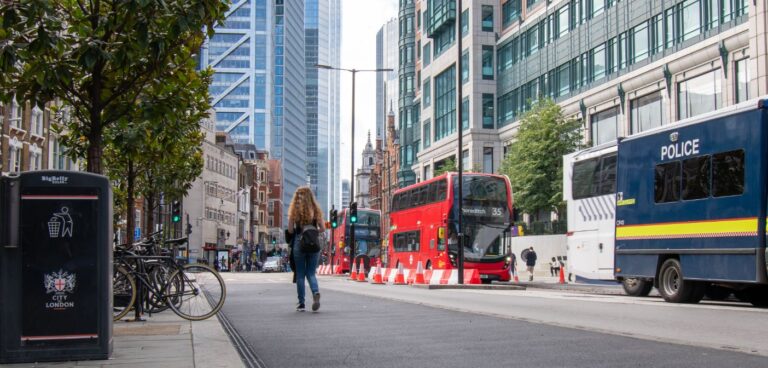Changes to transform a major central London traffic corridor have gone live.
The scheme – part of Transport for London’s (TfL’s) response to the coronavirus pandemic – is designed to prioritise people walking and cycling and enable people to maintain social distancing between Shoreditch and London Bridge.
The temporary restrictions on Bishopsgate and Gracechurch Street in the City of London – which came into operation on 1 September at 07:00 – are part of the Mayor of London and TfL’s Streetspace plans. The restrictions will be in operation on weekdays between 07:00 and 19:00.
Wider footways have been constructed along the corridor to give people on foot more space and a number of banned turns, which will be in operation 24 hours a day, will also be introduced along the road.
These temporary measures will continue to provide access for servicing and taxis for most of the corridor, except for two short sections of road – Middlesex Street to Liverpool Street, and Leadenhall Street to Fenchurch Street – where access to vehicles is restricted between 07.00 – 19.00. Access to buildings on these streets will be from either end of these sections, with direct access remaining at all other times.
According to TfL, the changes will be vital to supporting people moving through the area, as school children start to return from 1 September and as more people return to their workplaces and visit cultural and leisure destinations in central London.
Alexandra Batey, TfL’s director of investment delivery planning, said: “As people return to school, work and leisure across London, it’s absolutely vital that streets are able to cope with increased demand for walking and cycling if we are to avoid a car-led recovery from coronavirus.
“We’re running near normal levels of public transport services and are working hard to deliver extra space for walking and cycling right across the capital.
“The opening of the first walking and cycling priority corridor along Bishopsgate in central London is a significant step forward for our Streetspace programme and will make a real difference to people moving around this busy corridor between Shoreditch and London Bridge.”
Since May, Streetspace has led to more than 50km of new or upgraded cycle infrastructure being built or currently under construction, along with more than 16,500m2 of extra pavement space on the TfL network. TfL has also installed a total of 1,540 extra cycle parking spaces across London, focused around high streets and transport hubs.
Work has also completed on a major 3.7km temporary upgrade to an older cycle route, CS7, in southwest London. Work in Balham and Tooting has added new sections of protected cycle lane to the existing route, which is one of London’s busiest, making it safer for people wanting to cycle in the area and to central London.
TfL and Greenwich Council recently announced that work to transform roads for cycling between Greenwich and Woolwich has been fast-tracked to start next month, with plans including a complete overhaul of the Angerstein roundabout.
Furthermore, TfL and Lewisham Council have set out a series of measures to improve conditions for people cycling and using public transport between Lewisham and Catford, by making changes to entry to and exit from Lewisham High Street and extending bus lane operation to 24/7.
Planning work on further low-traffic corridors in central London continues, including between Old Street and Holborn, with further details to be set out in the autumn.





